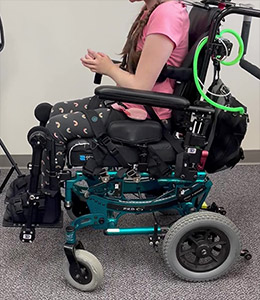Movement as a Human Right
Michelle L. Lange, OTR/L, ATP/SMS
In our last blog, we discussed The Importance of Movement within a Wheelchair Seating System. In this blog, I would like to address this from a more philosophical standpoint – Movement as a Human Right.
I have had the privilege of co-editing, along with Jean Minkel, PT, ATP, the 2nd edition of Seating and Wheeled Mobility: a clinical resource guide. One of the new chapters is Power Mobility Assessment: Determining Readiness and Providing On Time Mobility by Heather A. Feldner, PT, MPT, PhD, PCS, Samuel W. Logan, PhD, Andrina Sabet, PT, ATP. In this chapter, the authors address movement as a human right, in relation to provision of power mobility. And they do a fantastic job! If you are interested in this chapter or the entire 2nd edition, it should be available in December of 2024.
This concept of movement as a human right is so important and, I believe, goes beyond power mobility. Of course, this could include assistive technologies from canes, walkers, and gait trainers, through manual wheelchairs and power options such as adaptive ride-on cars, scooters, and power wheelchairs.
But what about Movement within a seating system?
Are we neglecting a person’s right to move when we provide aggressive seating interventions to maintain posture, yet not allow that person any ability to move within their seating system?
Are we neglecting a person’s right to move when we provide aggressive seating interventions to maintain posture, yet not allow that person any ability to move within their seating system?
My friend, colleague and co-editor, Jean Minkel, loves to say, “The tyranny of ‘Or’ and the genius of ‘And.’” Instead of providing postural support OR providing movement, can we provide postural support AND provide movement? I firmly believe we can and should.
Support for Movement as a Human Right
United Nations
In 2006, the United Nations held a Convention on the Rights of Persons with Disabilities.
Article 20 addresses Personal Mobility as a human right and states that parties shall take effective measures to ensure personal mobility with the greatest possible independence for persons with disabilities, including by:
- Facilitating the personal mobility of persons with disabilities in the manner and at the time of their choice, and at affordable cost;
- Facilitating access by persons with disabilities to quality mobility aids, devices, assistive technologies and forms of live assistance and intermediaries, including by making them available at affordable cost;
- Providing training in mobility skills to persons with disabilities and to specialist staff working with persons with disabilities;
- Encouraging entities that produce mobility aids, devices and assistive technologies to take into account all aspects of mobility for persons with disabilities.
The American Physical Therapy Association
The American Physical Therapy Association defines mobility within a limited scope as “…an individual moving by changing body positions or locations or by transferring from one place to another. This includes walking and wheeled mobility” (APTA, 2021). (Highlight added by me). This definition is not limited to movement between locations, but movement of the body itself.
Summary
Instead of providing postural support OR providing movement, can we provide postural support AND provide movement? I firmly believe we can and should
I believe that we can, and should, provide movement within a wheelchair seating system and that this is a basic human right for people with disabilities using this technology. While many people using wheelchair seating can move independently within that system, some are unable to. Other people’s movement within their seating system leads to a loss of position. One way of providing movement while maintaining position is through Dynamic Seating.
Please share your thoughts below so that we can continue to discuss this important topic.
References
- APTA. (2021). APTA Guide to Physical Therapist Practice 4.0. Guide.apta.org.
- United Nations Convention on the Rights of Persons with Disabilities, December 13, 2006. https://www.ohchr.org/en/hrbodies/crpd/pages/conventionrightspersonswithdisabilities.aspx

